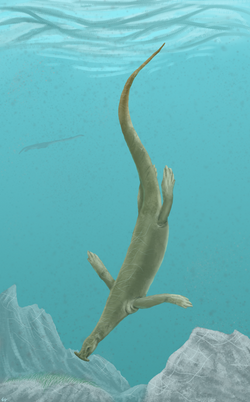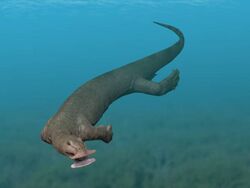Biology:Atopodentatus
| Atopodentatus | |
|---|---|

| |
| Life restoration in a swimming posture, with Dinocephalosaurus in the background | |
| Scientific classification | |
| Domain: | Eukaryota |
| Kingdom: | Animalia |
| Phylum: | Chordata |
| Class: | Reptilia |
| Clade: | Neodiapsida |
| Superorder: | †Sauropterygia |
| Genus: | †Atopodentatus Cheng et al., 2014 |
| Type species | |
| †Atopodentatus unicus Cheng et al., 2014
| |
Atopodentatus is an extinct genus of basal sauropterygian known from the early Middle Triassic (Anisian)[1] of Guanling Formation in Luoping County, Yunnan Province, southwestern China . It contains a single species, Atopodentatus unicus.[1] It is thought to have lived between 247 and 240 million years ago, during the Middle Triassic period, about six million years after the Permian extinction.[2][3][4] Atopodentatus was an herbivorous marine reptile, although marine reptiles are usually omnivores or carnivores.[3]
A near complete skeleton along with a left lateral portion of the skull were discovered near Daaozi village, Yunnan, China. The scientific name derives from the peculiar zipper-shaped morphology of the holotype specimen's jaws and unique dentition.[2] However, two fossil skulls discovered in 2016 indicate that the holotype skull was badly damaged, and that the living animal actually had a hammer-shaped head with shovel-like jaws.[5]
Description
Atopodentatus was a medium-sized reptile measuring about 2.75 m (9.0 ft) long.[1] The geological strata in which the fossil was found, the elongated body, reduced neck, robust appendages and hips of Atopodentatus all suggest that the animal was probably semi-aquatic in nature.[2][6]
Originally, the upper mandible of Atopodentatus was believed to have small teeth running along the jawline, and then up along a vertical split in the middle of the upper jaw. This gave the upper jaw the appearance of a "zipper smile of little teeth". The upper jaw was believed to have hooked downwards.[6] Discoveries in 2016, however, overthrew these findings, and revealed that Atopodentatus actually had a hammer-shaped head, with a bank of chisel-shaped teeth, that was useful in rooting the seabed for food.[7][8]
Discovery and naming
The genus name Atopodentatus is derived from the Ancient Greek atopos (άτοπος), meaning "unusual",[note 1] combined with Latin dentatus, "toothed", referring to the unusual arrangement and shape of the teeth. The specific name "unicus" is also in reference to its unique anatomy.[2]
Palaeoecology
Due to its bizarre dentition, Atopodentatus was formerly considered to be a filter feeder which fed on invertebrates along the sea-bottom.[6] It was suggested that the morphology made Atopodentatus "capable of walking on land or tidal flats and sandy islands in the intertidal zone".[1] However, the 2016 findings reveal that Atopodentatus actually ate algae from the seabed, making it the second known Mesozoic herbivorous marine reptile after the sphenodontian Ankylosphenodon.[9] Atopodentatus is the earliest known herbivorous marine reptile by about 8 million years.[3][note 2]
Notes
References
- ↑ 1.0 1.1 1.2 1.3 Cheng, L.; Chen, X. H.; Shang, Q. H.; Wu, X. C. (2014). "A new marine reptile from the Triassic of China, with a highly specialized feeding adaptation". Naturwissenschaften 101 (3): 251–259. doi:10.1007/s00114-014-1148-4. PMID 24452285. Bibcode: 2014NW....101..251C.
- ↑ 2.0 2.1 2.2 2.3 Prostak, Sergio (17 February 2014). "Atopodentatus unicus: Bizarre New Fossil Reptile Discovered in China". Sci-News.com. http://www.sci-news.com/paleontology/science-atopodentatus-unicus-new-fossil-reptile-china-01768.html.
- ↑ 3.0 3.1 3.2 Geggel,LiveScience, Laura. "Fearsome Dinosaur-Age "Hammerhead" Reptile Ate... Plants?". http://www.scientificamerican.com/article/fearsome-dinosaur-age-hammerhead-reptile-ate-plants/.
- ↑ "Ancient Reptile Ate Like an Underwater Lawn Mower". 2016-05-06. http://news.nationalgeographic.com/2016/05/160506-hammerhead-fossil-reptile-lawnmower-vegetarian/.
- ↑ Davis, Nicola (2016-05-06). "Atopodentatus was a hammerheaded herbivore, new fossil find shows". https://www.theguardian.com/science/2016/may/06/atopodentatus-was-a-hammerheaded-herbivore-new-fossil-find-shows.
- ↑ 6.0 6.1 6.2 Switek, Brian (5 February 2014). "Atopodentatus Will Blow Your Mind". Laelaps (blog). National Geographic Society. http://phenomena.nationalgeographic.com/2014/02/05/atopodentatus-will-blow-your-mind/.
- ↑ "Ancient hammerhead creature may have been world’s first vegetarian sea reptile". Science, By Sid Perkins. May 6, 2016.
- ↑ "Nailing the reconstruction of a hammerhead reptile". Toronto Star, May 14, 2016, page IN5. by Ben Guarino
- ↑ Reynoso, V. H. (2000). "An unusual aquatic sphenodontian (Reptilia: Diapsida) from the Tlayua Formation (Albian), central Mexico". Journal of Paleontology 74: 133–148. doi:10.1017/s0022336000031310.
- ↑ Chun, Li; Rieppel, Olivier; Long, Cheng; Fraser, Nicholas C. (2016). "The earliest herbivorous marine reptile and its remarkable jaw apparatus". Science Advances 2 (5): e1501659. doi:10.1126/sciadv.1501659. PMID 27386529. Bibcode: 2016SciA....2E1659C.
Wikidata ☰ Q15642618 entry
 |


